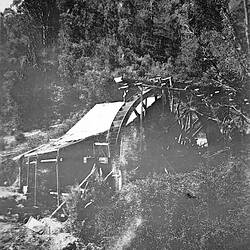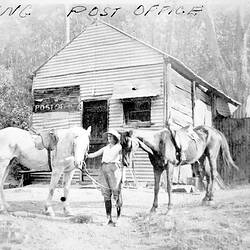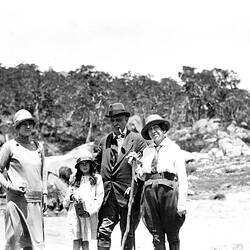Summary
Stirling was a small mining settlement on the Haunted Stream goldfield situated in rugged mountain country between Bairnsdale and Omeo. Alluvial gold had first been discovered in the area in 1863, causing a small rush that soon petered out. The discovery of several rich quartz reefs between 1882 and 1884 led to a revival, with the expanding settlement formed near the junction of Tierneys Creek and the Haunted Stream being named Stirling in 1889, in honour of the government geologist and surveyor, James Stirling (1852-1909), who had done much to assist the development of mining prospects throughout the district. Stirling had arrived in the Omeo district in 1877, working initially as a surveyor and foreman with the Crown Lands Department, before transferring to the Mines Department as an Assistant Geological Surveyor in April 1887. The town soon boasted two hotels, a wine saloon, boarding houses, a general store, butcher, baker, billiard room, post office, police station, recreation ground and Mechanics Institute Hall - which doubled as a schoolroom and church. The Haunted Steam State School (No.2845) opened in October 1887 and had an average attendance of 15 pupils throughout its first two decades.
The formation of the Stirling Proprietary Gold Mining Co. (No Liability) in 1898, marked the beginning of an era of renewed interest in quartz mining on the Haunted Stream goldfield, with new capital flowing from investors in Melbourne, Ballarat and Bendigo, and the establishment of over a dozen new mines. As mining activity extended up the winding valley, another settlement was established in 1902 near Sheepstation Creek, about 10 miles (16 kms) upstream of Stirling. It was named Dawson City after its far more populous namesake, which in the late 1890s had become world-famous as the epicentre of the Klondike goldfield in Canada's Yukon Territory, being the destination of the last great international goldrush of the 19th century.
Around Dawson City on Haunted Stream, a small cluster of quartz mines developed, operated mainly by co-operative parties and private partnerships, including the Stirling King, Secret, West Secret, Happy Moments and Star of Stirling G.M. Association. Alex Lamb, a Ballarat-based stockbroker and mining investor, installed a water-powered 6-head stamp battery to undertake public crushings and for almost a decade the mines thrived, treating mainly small parcels of hand-picked high-grade ore. By 1912, however, mining on the Haunted Stream goldfield was in an 'unusual depression' from which it would never recover, leaving the settlements of Stirling and Dawson City in terminal decline. The State School moved to a part-time teaching basis in 1914 and soon afterwards the post office was also closed. By 1916, only three small co-operative mining parties were still active on the field making 'a fair subsistence' from prospecting and picking over former workings, taking advantage of water-power milling machinery that could be operated at minimum expense. By December 1918, only three families still resided in the valley and it was reported that Stirling had 'practically passed into oblivion', with the trustees of the former Mechanics Institute anxious to dispose of the lending library of 600 books and sell the hall for removal, complete with its piano, before it fell victim to a bushfire.
Description of Content
View looking down a curved dirt track toward quartz crushing works associated with a gold mine on the Haunted Stream goldfields in Gippsland. The large steel chimney and firewood stacks provide confirmation of the use of steam power with the double-fronted skillion-roofed section at the near end of the building likely to have housed a steam boiler and stationary steam engine. The main gable-roofed building with a wide skillion-roofed extension at the front has the distinctive form of a stamp battery house, and from its size, was probably built to accomodate a battery of 10 to 20 stamp heads in total. A pipe extends from the front of the battery house running downhill to what appears to be part of a tailings dam or secondary tailings treatment area in the lower right-hand corner. On the hillside behind the battery house are the timber trestles and balustrade railings of what appears to be an elevated tramway, probably for the delivery of ore from the mine to hoppers behind the battery house. To the let beside the firewood stacks is a rough bush structure of split slab construction with a bark roof, possibly used as a workshop or blacksmith's shop. In front of the battery house are two rustic timber footbridges across a small gully, while from the right-hand end of the battery house a bridle track ascends the spur of the mountain range in the background. It is not know which of the nine stamp batteries on the Haunted Stream goldfield is depicted in this image, but it may be a view of the Hans Gold Mining Co. (N.L.), at Upper Stirling, which in 1905-6 installed a 20-head steam battery with four Wilfrey concentrators (for saving pyrites) - becoming the largest crushing plant on the field.
More Information
-
Collection Names
-
Collecting Areas
-
Acquisition Information
Copied from E. J. Conn, 09 Nov 1987
-
Place & Date Depicted
Stirling, Haunted Stream, East Gippsland, Victoria, Australia, 1911
-
Format
Negative, 35 mm, Black & White
-
Inscriptions
Handwritten across top of original negative/photograph: "STEAM DRIVEN QUARTZ / CRUSHING PLANT / STIRLING"
-
Classification
-
Category
-
Discipline
-
Type of item
-
References
The installation of a 20-head battery at the Hans Company mine, Stirling, in 1905 was described as follows:
"The directors of the Hans Co., Stirling, state that after having proved the Magazine lode by opening up, also by numerous assays and bulk trial crushing, to be of a payable character as well as of large extent, entered into negotiations for the purchase of the Exchange mining plant, Ballarat, including a good 20-head crushing battery. The purchase has been completed, and the machinery forwarded to the mine, and is now in course of erection. Two high-class multi-tubular boilers, having a steaming capacity of 120 h.p., have also been purchased, and are ready for transmission to the mine. Four Wilfley tables with the latest improvements have been ordered. These, when completed, will equip the mine with a thoroughly up-to-date plant, capable of treating a large quantity of milling ore at a low cost. The mine manager estimates that there is two years' crushing material now in sight for the battery to commence operating on, and as soon as the "Hans" lode is reached by a further 60ft. of crosscutting or thereabouts other large bodies will be available. The extraordinary wet season in East Gippsland has considerably delated operations both in the delivery of machinery from the mine and its erection besides adding to the cost of the works, consequently the original estimate that the plant would be completed by the end of October will be exceeded by a month at least."
'Mining. By L.S.D.', Punch (Melbourne), 2 Nov 1905, p.14, [Link 1]
In a letter to the Weekly Times, published in August 1915, former resident Edwin J. Conn recalled earlier life in the township of Stirling:
"SOMETHING ABOUT STIRLING. Edwin James Conn, who lives at Tambo Crossing, writes:- Dear Uncle Ben.- The place we lived in was Stirling. There used to be a lot of mines there, but here are only two working now. The ones that are working are doing very well. The last crushing was 84 ounces from 50 ton of stone. The other claim went 27 ounces from 20 ton of stone. There were nine batteries there a long time ago. One time there were hundreds of people. There were two hotels, three stores, and several boarding houses, a butcher's shop, a library, and a State school; now there are very few people living there, and no business places at nil. Supplies come from Ensay, a distance of over 23 miles. I am eight years and 10 months old. Please may I write again? (Yes. Edwin, you may write again -Uncle Ben)."
'Something About Sitrling', Weekly Times (Melbourne), Sat 21 Aug 1915, p.37, [Link 2]
-
Keywords
Battery Houses, Chimneys, Firewood, Forests, Gold Mining, Mining Equipment, Mountains, Ore Treatment Works, Quartz Crushing Machinery, Quartz Mining, Stamp Batteries, Steam Power, Timber Bridges, Tramways, Star Clusters, Celestial Bodies




